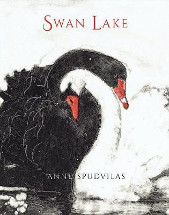Swan Lake by Anne Spudvilas

Allen and Unwin, 2017. ISBN 9781743318454
(Age: all) Highly recommended. Themes: Fairy tale, Love, Sorcery,
Murray Darling. When the prince returns from hunting, he stops by a
lake and there sees a flight of swans land, emerging from the lake
as beautiful young women. They have been cursed by an evil sorcerer
to live out their lives as swans by day and human by night. The
prince is enchanted by the Swan Queen and professes his undying
love. But she can only appear in human form at midnight. The next
night is a ball in his honour where he must choose a bride. He
resolves to choose her at midnight, but the sorcerer presents his
daughter as the Swan Queen and mistakenly the prince is betrothed to
her.
The real Swan Queen goes back to her lake distraught, but the prince
realising his mistake, kills the sorcerer and finds her and together
they choose to be in the lake for all time.
This story has been well known for over a century, made famous by
the powerful ballet composed by Tchaikovsky, and presented in 1876
to a less than favourable reception. The story is said to be based
on Russian folk tales, particularly the tale of Odette the swan
queen held prisoner under the curse of a sorcerer.
In this book, the beautiful illustrations by Spudvilas will remain
with the reader. Printmaking in all its guises are used to create
graceful, elegant depictions of the swans, with contrasting
powerful, overwhelming images of the sorcerer and his daughter.
Looking closely at the pages, readers will be able to see how
Spudvilas has used various print techniques: collagraphs,
monoprints and etchings to create this magnificent book of images.
Each is distinctive and visually enticing, grabbing the reader as
the eye passes over each page, impelling the reader to look more
closely at each illustration. The contrast on many pages is between
the black and the white, the colours of the Swan Queen and the
sorcerer's daughter. Within the black are touches of red,
reinforcing the treachery of the sorcerer and his daughter, while
other small subtle colouring appears. Spudvilas has recently moved
to the Murray Darling, and it becomes obvious to the reader that the
story is framed by the foggy imagery of trees along the Murray, of
small islets, of tiny waterways, while the prince and his love are
taken by the swirling waters of the lake.
I spent a lot of time mesmerised by every page and I am sure all
readers will do the same, breathing in the atmospheric
illustrations, while in awe of the artistry involved.
Fran Knight